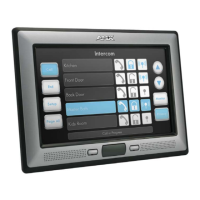Appendix B - Text Area Input Masking
200
NXD-1000Vi 10" Modero® Wall/Flush Mount Touch Panel with Intercom
Input Mask Ranges
These ranges allow a user to specify the minimum and maximum numeric value for a field.
Only one range is allowed per field.
Using a range implies a numeric entry ONLY.
An example from the above table:
[0|255] This allows a user to enter a value from 0 to 255.
Input Mask Next Field Characters
These characters allow you to specify a list of characters that cause the keyboard to move the focus to the next
field when pressed instead of inserting the text into the text area.
An example from the above table:
{.} or {:} or {.:} Tells the system that after a user hits any of these keys, proceed to the next text field.
Input Mask Operations
Input Mask Operators change the behavior of the field in the following way:
Input Mask Literals
To define a literal character, enter any character, other than those shown in the above table (including spaces,
and symbols).
A back-slash ('\') causes the character that follows it to be displayed as the literal character. For example, \A is
displayed just as the letter A. To define one of the following characters as a literal character, precede that
character with a back-slash. Text entry operation using Input Masks.
A keyboard entry using normal text entry is straightforward. However, once an input mask is applied, the
behavior of the keyboard needs to change to accommodate the input mask's requirement.
When working with masks, any literal characters in the mask will be "skipped" by any cursor movement
including cursor keys, backspace, and delete.
When operating with a mask, the mask should be displayed with placeholders.
The "-" character should display where you should enter a character. The arrow keys will move between the "-
" characters and allow you to replace them. The text entry code operates as if it is in the overwrite mode. If the
cursor is positioned on a character already entered and you type in a new (and valid) character, the new
character replace the old character. There is no shifting of characters.
When working with ranges specified by the [] mask, the keyboard allows you to enter a number between the
values listed in the ranges.
If a user enters a value that is larger than the max, the maximum number of right-most characters is used to
create a new, acceptable value.
Input Mask Ranges
Character Meaning
[ Start range
] End range
| Range Separator
Input Mask Next Field Char
Character Meaning
{ Start Next Field List
} End Next Field List
Input Mask Operators
Character Meaning
< Forces all characters to be converted to lowercase
> Forces all characters to be converted to uppercase
^ Sets the overflow flag for this field

